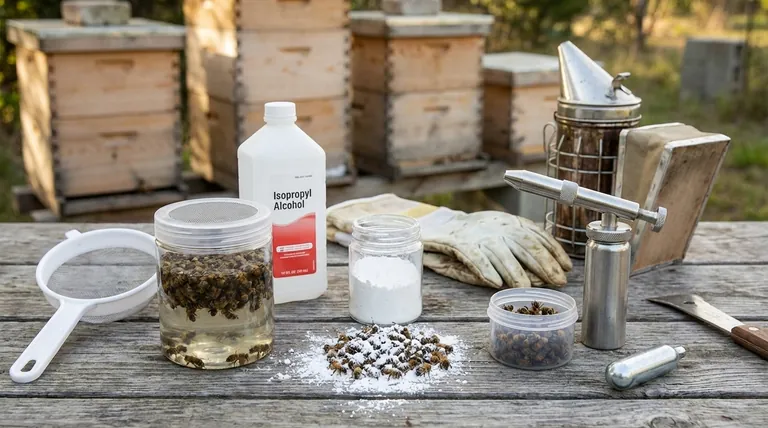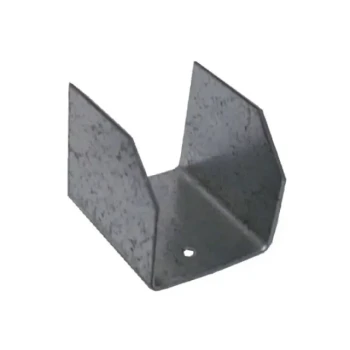The most recommended methods for monitoring Varroa mites are the alcohol wash, the sugar roll, and the CO2 injection. While all three are effective at dislodging mites from a sample of bees for counting, the alcohol wash is widely considered the most accurate and reliable method for making critical treatment decisions.
The core principle of hive management is that you cannot manage what you do not measure. While methods that spare bees exist, the alcohol wash provides the most accurate data on mite infestation levels, empowering you to protect your entire colony with timely and effective treatment.

Why Consistent Monitoring is Non-Negotiable
Varroa destructor mites are the single greatest threat to honey bee health worldwide. Effective management is impossible without first understanding the scale of the problem within each individual hive.
The Hidden Threat of Varroa
Mites are more than just parasites; they are vectors for deadly viruses. A low mite count can quickly escalate, weakening the colony's collective immune system and leading to a sudden collapse, often in late summer or fall.
Establishing a Baseline
Regular monitoring, typically on a monthly basis during the active season, allows you to establish a baseline mite level for each colony. This data shows you the trend over time—whether the mite population is growing, shrinking, or stable.
Making Data-Driven Treatment Decisions
Monitoring provides a clear "mite load" percentage (mites per 100 bees). This number tells you precisely when to intervene, helping you avoid unnecessary chemical treatments while ensuring you act decisively before the infestation becomes uncontrollable.
A Detailed Look at Each Monitoring Method
Each method involves collecting a standard sample of bees—typically a 1/2 cup, which is approximately 300 bees—from a frame of brood to get an accurate assessment.
The Alcohol Wash: The Gold Standard for Accuracy
This is the method most preferred by researchers and commercial beekeepers for its reliability. The bee sample is submerged in isopropyl alcohol, which quickly kills the bees and causes the mites to detach completely.
Shaking the container for 60 seconds ensures all mites are dislodged. The mites are then counted, and the number is divided by 3 (since 300 bees were sampled) to get the mite percentage.
The Sugar Roll: The Live-Bee Alternative
In this method, the sample of bees is placed in a jar with powdered sugar. The fine sugar particles are thought to irritate the mites' pads, causing them to lose their grip on the bees.
After gently rolling the bees in the sugar, the jar is shaken over a white surface to dislodge the mites for counting. The bees, covered in sugar, can then be returned to the hive.
The CO2 Injection: A Faster, Live-Bee Method
This technique uses a specialized canister to inject CO2 into a container holding the bee sample. The CO2 briefly anesthetizes the bees and mites, causing the mites to fall off.
The container is then shaken for about 15-20 seconds, and the dislodged mites are counted. This method is fast, but it requires an initial investment in the CO2 injection equipment.
Understanding the Trade-offs: Accuracy vs. Bee Safety
Choosing a method involves a direct trade-off between the desire to preserve the life of every bee in the sample and the need for highly accurate data to protect the entire colony.
The Cost of Inaccuracy
The primary drawback of the sugar roll is its variability. Its effectiveness can be influenced by ambient humidity, and it frequently underestimates the true mite load. An inaccurate, low reading can provide a false sense of security, leading a beekeeper to delay treatment and ultimately lose the entire colony.
The Cost of Accuracy
The alcohol wash requires sacrificing the ~300 bees in the sample. While this is understandably difficult for many beekeepers, it must be placed in context. A healthy queen lays over 1,500 eggs per day, so the loss of 300 bees is statistically insignificant to the colony's population and long-term survival.
Why Consistency is Key
Regardless of the method you choose, the most important factor is consistency. By using the same method at the same time each month, you can accurately track the trend of your mite population, which is just as important as the absolute number from a single test.
Choosing the Right Method for Your Apiary
Your choice should align with your management philosophy and goals. Use the economic threshold of a 2-3% mite load (2-3 mites per 100 bees) as the point at which treatment is generally required.
- If your primary focus is maximum accuracy for data-driven decisions: The alcohol wash is the definitive industry standard and provides the most reliable information to protect your investment.
- If your primary focus is preserving every bee in the sample: The sugar roll is a viable no-kill option, but you must be aware of its potential to underestimate mite loads and adjust your treatment threshold accordingly.
- If your primary focus is speed and a no-kill approach: The CO2 injection method offers a great balance of speed and bee safety, provided you are willing to invest in the necessary equipment.
Ultimately, the best monitoring method is the one you will perform consistently to safeguard the health and productivity of your colonies.
Summary Table:
| Method | Accuracy | Bee Survival | Key Feature |
|---|---|---|---|
| Alcohol Wash | Highest | No | Industry gold standard for reliability |
| Sugar Roll | Variable (often lower) | Yes | No-kill, live-bee alternative |
| CO2 Injection | High | Yes | Fast, requires specialized equipment |
Protect Your Investment with Data-Driven Hive Management
Consistent and accurate mite monitoring is the foundation of successful apiary management. For commercial beekeepers and equipment distributors, the right tools are essential for making informed treatment decisions that protect colony health and productivity.
HONESTBEE supplies the professional-grade equipment you need for reliable monitoring, from durable sampling jars to CO2 injection systems. Our wholesale-focused operations are designed to support the scale and demands of commercial apiaries.
Ready to equip your operation with the best? Contact our team today to discuss your specific needs and explore our range of beekeeping supplies.
Visual Guide

Related Products
- Nicot Queen Rearing Kit for Beekeeping and Grafting in Nicot System
- Jenter Queen Rearing Kit Complete Set for Bee Breeding
- Retractable Chinese Queen Rearing Grafting Tools Equipment
- Professional Galvanized Hive Strap with Secure Locking Buckle for Beekeeping
- No Grafting Queen Rearing Kit: System for Royal Jelly Production and Queen Rearing
People Also Ask
- What should be done once eggs are present in the comb box? A Guide to Maximizing Queen Rearing Success
- What are the methods of queen rearing? Master Grafting, Direct Lay & More
- What happens if a larva is grafted too late? Avoid Scrub Queens and Failed Rearing
- What should be done to ensure grafted larvae are well-fed? Master the Principle of Abundance for Queen Rearing
- What are the different methods for raising queen bees? Master the Trade-Off Between Simplicity and Control



















